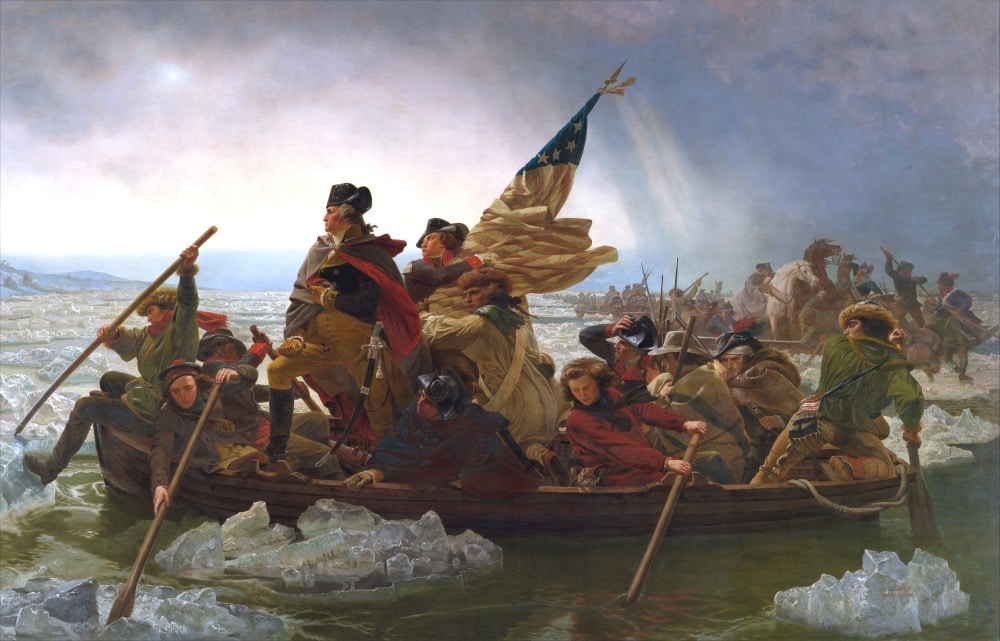American History | Modul 8 | Klassenmodul: News Report | Krieg | ◻◻ mittel | ca. 90 min
 Emanuel Gottlieb Leutze: Washington Crossing the Delaware, Historiengemälde von 1851 | Vollständiges Bild und Bildnachweis (Public Domain, Wikimedia): Bild anklicken
Emanuel Gottlieb Leutze: Washington Crossing the Delaware, Historiengemälde von 1851 | Vollständiges Bild und Bildnachweis (Public Domain, Wikimedia): Bild anklicken
Attention! You can only work on this module if the entire class is participating. Ask your teacher whether you can produce a news report as it requires a lot of preparation time. You can start working on this module as soon as you and your classmates have completed module 6. Get together in groups of 4 to 5 pupils.
On April 19th, 1775, a “shot heard around the world“ was fired at Lexington, Massachusetts and ignited the battles of Lexington and Concord. These battles marked the outbreak of the open armed conflict between Britain and thirteen of its North American colonies known as the Revolutionary War. This war, also called the ‚American War of Independence‘, lasted from 1775 to 1783 and resulted in a defeat of the British troops. Eventually, the new United States of America were founded.
Imagine you are a team of public TV reporters describing the recent events in America. Your news report provides information on the current situation on-site the conflict, but it also considers the reasons for the conflict and points out possible consequences.
Aufgaben
1 | Before starting any news report, it is important to do some research on the event you are reporting on. Collect information on the Revolutionary War: Its cause, outbreak, and course. You may use the results from your work on the module Conflict with Britain or look up the most important events of the Revolutionary War in this timeline. Decide which event of the war is covered by your news report and then try to find as many answers to the ‘w’-questions (what, who, when, where, why) as possible.
- Think of the perspective you choose as a reporting team. You have to decide whether you are working for an American, a British or a European TV station.
- You should plan how you want to start your report and how you want to end it. This will keep your story heading in the right direction, and you woill not miss out any important information. Make a story board and follow it! The following phrases may help you:
Introduction – The reporter in the TV studio introduces the story. Keep it short, simple and catchy!
Interview(s) – The person the correspondent talks to gives his/her opinion on what is happening and how it affects him/her. More than one person should be interviewed to provide the audience with different perspectives on the event.
Conclusion – The reporter in the TV studio signs off by pointing out potential problems related to the event / summarizing the outcome or possible outcome of the event.
|
- Think about the audience listening to your story and how you can make the story interesting to them. Bring your story to life and try to tell it in the most engaging way without making it too complicated. Think of a good beginning to catch the audience’s attention and of a memorable conclusion to leave an impression.
2 | Now it is time to shoot your news report.
- Decide who takes which role (news reader in the TV-studio, reporter on-site, interviewees).
- Write down the news reader’s script on large cue cards. When you shoot the news report, place the cards just behind and to the site of the camera. This way the news reader will make fewer mistakes and sound more professional. You may also write some cue cards for the reporter on-site.
- Try to find a good spot to tell your story. It is always useful to film pictures showing what is happening at the location to explain what you are talking about. Using different backgrounds and angles for your shots will keep your news report interesting for the audience.
- You might want to use some suitable props to emphasise your acting.
3 | Have a look at all the news reports your classmates created and compare their content.
Which differences can you identify between American, British and European broadcasting? Explain how this is related to history or historiography, respectively.
